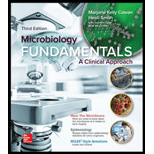
Microbiology Fundamentals: A Clinical Approach
3rd Edition
ISBN: 9781259709227
Author: Marjorie Kelly Cowan Professor, Heidi Smith
Publisher: McGraw-Hill Education
expand_more
expand_more
format_list_bulleted
Concept explainers
Question
Chapter 4.5, Problem 20AYP
Summary Introduction
To enlist:
The two major groups of helminths with examples representing each body type.
Concept introduction:
Helminths constitute all the tapeworms, roundworms, and flukes. While adult helminthes can be seen by the naked eye, they produce microscopic larvae and eggs. Many helminth species are responsible for causing infections in humans and animals.
Expert Solution & Answer
Want to see the full answer?
Check out a sample textbook solution
Students have asked these similar questions
The Sentinel Cell: Nature’s Answer to Cancer?
Molecular Biology Question
You are working to characterize a novel protein in mice. Analysis shows that high levels of the primary transcript that codes for this protein are found in tissue from the brain, muscle, liver, and pancreas. However, an antibody that recognizes the C-terminal portion of the protein indicates that the protein is present in brain, muscle, and liver, but not in the pancreas. What is the most likely explanation for this result?
Molecular Biology
Explain/discuss how “slow stop” and “quick/fast stop” mutants wereused to identify different protein involved in DNA replication in E. coli.
Chapter 4 Solutions
Microbiology Fundamentals: A Clinical Approach
Ch. 4.1 - Relate bacterial, archaeal, and eukaryotic cells...Ch. 4.1 - List the types of eukaryotic microorganisms, and...Ch. 4.2 - Differentiate among the flagellar structures of...Ch. 4.2 - List similarities and differences between...Ch. 4.2 - Describe the main structural components of a...Ch. 4.2 - Diagram how the nucleus, endoplasmic reticulum,...Ch. 4.2 - Prob. 7AYPCh. 4.2 - Explain the importance of ribosomes, and...Ch. 4.2 - List and describe the three main fibers of the...Ch. 4.2 - Prob. 10AYP
Ch. 4.2 - Prob. 1NPCh. 4.3 - Prob. 11AYPCh. 4.3 - Prob. 12AYPCh. 4.3 - Differentiate among the terms heterotroph,...Ch. 4.3 - Prob. 14AYPCh. 4.3 - Prob. 15AYPCh. 4.3 - Q. Yeast infection is one common side effect of...Ch. 4.3 - Prob. 2MMCh. 4.4 - Prob. 16AYPCh. 4.4 - Prob. 17AYPCh. 4.4 - Explain why a cyst stage may be useful to a...Ch. 4.4 - Prob. 19AYPCh. 4.4 - Prob. 2NPCh. 4.5 - Prob. 20AYPCh. 4.5 - Summarize the stages of a typical helminth life...Ch. 4.5 - Prob. 3NPCh. 4.5 - Prob. 3MMCh. 4 - Mitochondria likely originated from a. archaea. b....Ch. 4 - Summarize the endosymbiotic theory and explain how...Ch. 4 - Prob. 3QCh. 4 - Prob. 4QCh. 4 - Compare and contrast the structure and function of...Ch. 4 - Prob. 6QCh. 4 - Prob. 7QCh. 4 - Considering the role of fungi in nature, speculate...Ch. 4 - Prob. 9QCh. 4 - Prob. 10QCh. 4 - Prob. 11QCh. 4 - Prob. 12QCh. 4 - Prob. 13QCh. 4 - Prob. 14QCh. 4 - Do you suppose any of these eukaryotic microbes...Ch. 4 - Which of these groups causes the most casualties...Ch. 4 - Prob. 17QCh. 4 - Do you suspect that the fact that humans use...Ch. 4 - Which of the following is not useful to determine...Ch. 4 - Why were protozoa originally considered a single...Ch. 4 - Write a paragraph that would explain the...Ch. 4 - From chapter 2, figure 2.1. Discuss how the...
Knowledge Booster
Learn more about
Need a deep-dive on the concept behind this application? Look no further. Learn more about this topic, biology and related others by exploring similar questions and additional content below.Similar questions
- Molecular Biology Question A gene that codes for a protein was removed from a eukaryotic cell and inserted into a prokaryotic cell. Although the gene was successfully transcribed and translated, it produced a different protein than it produced in the eukaryotic cell. What is the most likely explanation?arrow_forwardMolecular Biology LIST three characteristics of origins of replicationarrow_forwardMolecular Biology Question Please help. Thank you For E coli DNA polymerase III, give the structure and function of the b-clamp sub-complex. Describe how the structure of this sub-complex is important for it’s function.arrow_forward
- Molecular Biology LIST three characteristics of DNA Polymerasesarrow_forwardMolecular Biology RNA polymerase core enzyme structure contains what subunits? To form holo enzyme, sigma factor is added to core. What is the name of the structure formed? Give the detailed structure of sigma factor and the function of eachdomain. Please help. Thank youarrow_forwardMolecular Biology You have a single bacterial cell whose DNA is labelled with radioactiveC14. After 5 rounds of cell division, how may cells will contain radioactive DNA? Please help. Thank youarrow_forward
- 1. Explain the structure and properties of atoms and chemical bonds (especially how they relate to DNA and proteins). Also add some pictures.arrow_forward1. In the Sentinel Cell DNA integrity is preserved through nanoscopic helicase-coordinated repair, while lipids in the membrane are fortified to resist environmental mutagens. also provide pictures for this question.arrow_forwardExplain the structure and properties of atoms and chemical bonds (especially how they relate to DNA and proteins). Also add some pictures.arrow_forward
- In the Sentinel Cell DNA integrity is preserved through nanoscopic helicase-coordinated repair, while lipids in the membrane are fortified to resist environmental mutagens. also provide pictures for this question.arrow_forward1. Explain how genetic information is stored, copied, transferred, and expressed. Also add some pictures for this question.arrow_forward!. Describe biological macromolecules (DNA, RNA, proteins, lipids, etc.) and how they function in the cell. also provide some images for this question.arrow_forward
arrow_back_ios
SEE MORE QUESTIONS
arrow_forward_ios
Recommended textbooks for you
 Biology: The Dynamic Science (MindTap Course List)BiologyISBN:9781305389892Author:Peter J. Russell, Paul E. Hertz, Beverly McMillanPublisher:Cengage Learning
Biology: The Dynamic Science (MindTap Course List)BiologyISBN:9781305389892Author:Peter J. Russell, Paul E. Hertz, Beverly McMillanPublisher:Cengage Learning



Biology: The Dynamic Science (MindTap Course List)
Biology
ISBN:9781305389892
Author:Peter J. Russell, Paul E. Hertz, Beverly McMillan
Publisher:Cengage Learning


